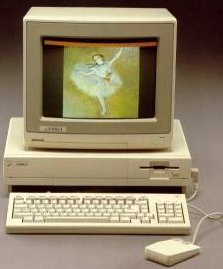
Commodore Amiga
1000

Developer: Commodore
Launched: July 23, 1985
Discontinued: January 1987 |
Commodore launched the Commodore Amiga in a grandiose show at
the Lincoln Center in New York on July 23, 1985. The machine itself
was based upon the earlier Lorraine project. The unit went on
sale a few months later, retailing at $1295.00 US dollars.
The company were pressured by Atari to launch the Commodore Amiga
ahead of their original schedule . The company had attempted to buy
the Amiga technology but had been forced to develop their own 68000
machine based upon off-the-shelf parts. In spite of a shorter
development time, the Atari 520ST beat the Commodore Amiga to the
market by several months. As a result, Amiga Workbench 1.1 (the Amiga disk based OS)
was buggy and prone to crashes.
At the time the Commodore Amiga was far in advance of its
competitors: the IBM PC market was using a 16 colour CGA display
and the Apple Macintosh was limited to a B/W display. These
specifications are taken from the original advertising for the
A1000 in the USA. The Atari continued to beat the Amiga in the
market for several years, in part, due to Commodore's focus upon
the high-end market. It is only when the Amiga
500 was launched that Commodore were able to beat Atari in the
home computer market. In 1987 the model number of the
Commodore Amiga was combined with the name to
officially designate the machine as the Commodore Amiga
1000.
| CPU |
MC68000 32 bit internal bus
16 bit data bus
7.16MHz clock speed |
| RAM |
256K Chip RAM as standard, expandable to 512K internally
Externally expandable to 8Mb Fast ram
256K writable control store |
| Graphics |
Resolutions available
320x200 32 colours
- 320x400 32 colours
- 640x200 16 colours
- 640x400 16 colours
Colour palette of 4096 colours
Eight reusable, 16 bit wide sprites.
60/80 column coloured text.
Programmable interobject priority and collision detection.
Custom animation chip
Utilizes a bit-blitter for high-speed movement of graphical
data.
Frees the CPU for other tasks.
Displays synchronized coprocessor.
Controls DMA (Direct Memory Access) channels. |
| Display |
RGB analogue monitor, NTSC composite monitors and television
compatible. |
| Sound |
Four-voice sound output at two-channel stereo.
Nine octaves.
Uses amplitude and frequency modulation.
I/O control for disk data and mouse/joystick ports.
Allows the disk and sound to operate with a minimum CPU usage. |
| User Interface |
"Intuition."
Pull down menus
Mouse or keyboard controlled.
Up to 50 overlapping windows, each running simultaneously in real
time.
Features the "Workbench" iconic user interface. AmigaDOS |
| Keyboard |
Detachable 89 key "typewriter" keyboard.
10 programmable function keys.
2 special function "Amiga" keys.
4 directional cursor keys. |
| Audio output |
Two RCA audio output jacks.
Signal to noise ratio = 70db.
Frequency response = 20-6000Hz.
Impedance = 300 ohms. |
| Input/Output |
Analogue RGB video port.
RF modulator for home televisions.
NTSC composite video port.
Two reconfigurable controller port, supports mouse and joystick
etc.
Eternal floppy disk port.
RS232 serial ports.
Reconfigurable Centronics parallel port.
Expansion port.
RAM expansion port.
Keyboard connector. |
| Peripherals |
3.5 double-sided disk drive
Two button opto-mechanical mouse. |
| Bundled software |
AmigaDOS.
Amiga Basic.
Amiga Tutorial.
Kaleidoscope.
Voice synthesis library. |
| Weight |
Approx. 13lbs |
| Dimensions |
4.25" height x 17.75" width x 13 depth. |
| Power requirements |
120 volts, 90 watts, 60Hz, 1A. |
Different Market. Different
Name.

Long time Amiga users will remember Commodore's change in
direction for the CDTV in the European market, selling it as the
Amiga CDTV. This is a common practice in marketing allowing
companies to tailor their brand to a geographical market in a style
that will maximize profits (in other words, to sell more
computers). When the Amiga moved from America to Europe the Amiga
name was unknown. To create a recognizable market presence
Commodore chose to place greater emphasis upon their own name as a
means of marketing the machine. This is immediately recognizable
with the greater emphasis placed upon the Commodore name as a
recognizable brand. In Europe the Amiga was seen as a descendent of
the C64 rather than a clean break from the past. This had its
advantages and disadvantages- it created an immediate market
presence based upon the Commodore 8-bit market. However, it
downplayed its role as a business machine.
Gallery
A1000 Box - 1 (64.7k) | A1000 Box -2 (36.9k) | Close-up of A1000 box (39.8k) | Close-up of the A1000 unit (30.1k)
Relevant Links
A1000 Press Release | Amiga Facts | A1000 Memory
Map | The Amiga Chronology
Thanks to Doug Spence for his contribution to
the A1000 press release.
BACK
Last Update: 6/3/2002
|













